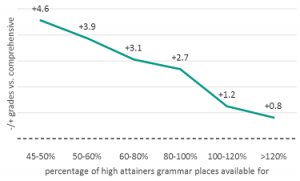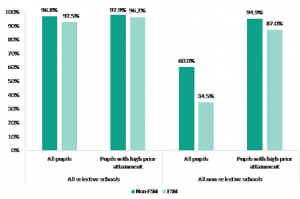This morning, the Education Select Committee will hold an ‘Evidence Check’ session in which they will question Nick Gibb (the Schools Minister), the Chief Analyst at the Department for Education and other academics on the evidence base for the government’s proposals to expand grammar schools.
In September, the Education Policy Institute published new research on the impact of selective schools and the potential consequences of opening new grammar schools. Ahead of today’s Select Committee hearing, we recap on the evidence from our research.
1. Nationally, there is no overall attainment impact of grammar schools.
Pupils attending a grammar school achieve, on average, one third of a grade higher in each of 8 GSCEs, compared with similar pupils in comprehensive schools. For disadvantaged pupils (those eligible for Free School Meals) who attend a grammar school, this positive effect is estimated at around half a grade in each of 8 GCSEs.
However, because the number of pupils who attend a grammar school are so few (only 5.2 per cent of the total GCSE cohort) and because in some areas there appears to be a small negative effect on those who do not attend grammar schools, there is neither a net positive nor net negative impact at a national level.
2. Pupils who attend a grammar school do better than similar pupils in comprehensives, but these effects diminish as an area becomes more selective.
Our report also looked at whether the effectiveness of grammar schools changed in areas where larger numbers of high-attaining children could secure places at a grammar school within reasonable travel distance. We found that the positive impact of grammar schools (an improvement of a third of a grade higher in each of 8 GCSEs), gradually reduced as the availability of places for high-attaining pupils increased.
In areas where there are more grammar school places than there are high attaining pupils, the benefit for pupils who attend grammar schools reduces to 0.1 of a grade in each of 8 GCSES. This is shown in the graph below.
In areas with the most selective places, grammar school ‘best 8’ GCSE bonus for similar pupils, relative to comprehensive schools elsewhere
3. We also found that pupils who attend grammar schools do no better than similar pupils in high performing comprehensives (those in the top 25% for value added)
We also compared the attainment of high-performing pupils who attended a grammar school, with those who attended a top performing comprehensive school (these are schools in the top 25 per cent as measured by value-added progress).
We found that, for these pupils, there was no difference in their results. For the remaining children attending top-performing comprehensive schools (the middle and low attainers), their GCSE outcomes were much better than similar pupils in selective areas (those that did not attend nearby grammar schools). Top-performing comprehensives are much more socially inclusive than grammar schools and deliver good results on average for all pupils.
4. In highly selective areas, a negative effect emerges for those who do not go to grammar schools
We then found that the attainment of pupils who do not attend a grammar school also diminishes as the number of grammar school places increases. In areas where there are grammar school places for 70 per cent or more of high attaining pupils, a negative effect begins to emerge for pupils who do not attend grammar schools. This is shown in the graph below. For all areas with grammar places for over 45 per cent of high attainers, we estimate this to be 0.1 grade lower in each of 8 GCSEs.
In areas with the most selective places, ‘best 8’ GCSE results for similar pupils in non-selective schools, relative to comprehensive schools elsewhere

For disadvantaged pupils (as measured by eligibility for Free School Meals), the negative effect is larger at almost 0.2 grades in each of 8 GCSEs.
This is where the Department faces a political dilemma. Polling undertaken by YouGov in September 2016 found that demand for more grammar schools was higher in highly selective areas. In areas with no selection, demand was much lower. But, as our analysis finds, grammar schools can be damaging to pupils (who do not attend grammars) in areas of high selection. In short, the government faces a dilemma because where there is likely to be most support for new places, these are not likely to have a positive attainment effect.
Our research also finds that pupils are likely to travel, on average, twice as far to attend a grammar school than a non-grammar school. The Department for Education estimate this to be 3 times further and cite this as evidence that grammar schools are popular with parents. But longer travel distances for pupils attending grammar schools are unsurprising and likely to be a feature of any system that has an element of selection. In fact, increasing selection is likely to increase the average travel distance nationally since pupils will be less likely to attend a local school as many will not be eligible to do so.
5. Disadvantaged pupils are significantly under-represented in grammar schools
Pupils eligible for Free School Meals make up 13.2 per cent of the state-funded secondary school population. Yet, in grammar schools, only 2.5 per cent of pupils are eligible for Free School Meals. While grammar schools tend to be located in more affluent areas, pupils eligible for Free School Meals still make up 8.9 per cent of the secondary-aged population in wholly-selective areas – and so geographical location is not solely to blame for this lack of representation.
One of the main barriers for disadvantaged pupils is their attainment at age 11. By the end of primary school, disadvantaged pupils are already, on average, almost ten months behind their peers . This means that these pupils are less likely to pass the 11+ entrance test to grammar schools. The graphic below shows how only around 6 per cent of disadvantaged children are found in the top quarter of the attainment distribution at the end of primary school.
Distribution of Key Stage 2 attainment in 2015 by eligibility for free school meals

But, even when we take into account that around 6 per cent of disadvantaged pupils achieve a level of attainment on par with the grammar school entrance requirements, they are still under-represented as less than half of that proportion actually attend a grammar school.
6. The gap between disadvantaged and non-disadvantaged pupils is bigger in wholly selective local authorities than in other areas
In non-selective local authorities, the gap between pupils on Free School Meals and all other pupils is 27.8 percentage points (as measured by the proportion achieving five or more A*-C GCSEs, including English and maths). But in wholly selective authorities, the gap rises to 34.1 percentage points.
In a recent PQ (number 47648 ), the Schools Minister states that “…the attainment gap for disadvantaged students in grammar schools is practically eliminated.”
This is true. The gap between disadvantaged pupils and the rest in grammar schools is 4.3 per cent, compared with a national gap of 27.8 percentage points. But this does not give a meaningful comparison.
First, it is important to consider the impact of selection on the attainment gap for all pupils living in the area, not just the few who attend them. As set out above, the attainment gap is, on average, wider in wholly selective local authorities than it is elsewhere. Our research shows that in areas with high levels of selection there is a penalty, in terms of GCSE outcomes, for those that do not attend grammars. These pupils are disproportionately from disadvantaged backgrounds.
Second, it is not surprising that the attainment gap in grammar schools is narrower than that seen nationally. This is because, by definition, grammar schools are selecting from a narrow band of prior attainment (i.e. they select some of the country’s highest performing pupils). By doing so, one of the major sources of the variation in pupil outcomes in GCSE – and in turn the attainment gap – is removed.
As our report explains, a more accurate way of comparing the gap for these purposes is to observe only those with the highest prior attainment at the end of Key Stage 2 (those who were in the top quartile). As the graph below shows, the gap between the highest performing disadvantaged pupils and the rest in grammar schools falls, but so too does the gap in comprehensive schools.
Proportion of pupils with high prior attainment that achieved 5+ A*-C grades at GCSE or equivalent, including English and mathematics, in selective and non-selective schools 2015

7. Disadvantaged pupils who live in a wholly selective local authority but do not go to a selective school, have lower attainment than those who live in a non-selective authority.
In non-selective local authorities, 33.3 per cent of disadvantaged pupils achieve five A*- C GCSEs but, in wholly selective areas, this falls to 30.1 per cent.
The graph below shows how disadvantaged pupils (who do not attend a grammar school) tend to do worse in wholly and partially selective authorities, compared to non-selective authorities.
Proportion of pupils attaining 5+ A*-C grades at GCSE or equivalent, including English and mathematics, by FSM status and school type, 2015
8. A quota system which requires grammar schools to take on more disadvantaged pupils is likely to have only a modest effect on the composition of selective schools and their ability to improve attainment for these pupils.
As we explain earlier in this paper, only 6 per cent of disadvantaged pupils achieve a level of attainment by the end of primary, that is on par with the grammar school entrance requirements. And so, even if grammar schools were required to implement a quota, there simply aren’t enough high attaining disadvantaged pupils to replicate national pupil compositions.
As we also find in our report, the positive effect of attending a grammar school diminishes as the number of grammar school places increases. In order to offset the negative effect of grammar schools for disadvantaged pupils, the government would need to expand the number of grammar school places (in the most selective areas) by a fifth, and move 1,600 additional disadvantaged pupils into these schools.
But, in doing so, the expansion in the number of grammar school places would also result in a diminished positive effect for those that attend. Essentially, the more grammar school places you have, the more you need to offset the growing penalty on other disadvantaged pupils locally, because the benefit of each place shrinks.
What Next?
The Department’s consultation on this issue ‘Schools that work for everyone’ closes on the 12th December. Ahead of that, the Education Policy Institute will be publishing new research on the impact of faith schools and other socially selective schools, the feasibility of a ‘tutor-proof’ 11+ examination and a more in-depth look at our findings in relation to quotas and highly selective areas.
We will also be looking at the impact of grammar schools on A-Level results and university entry. This is particularly important in adding to what we know about the impact of grammar schools beyond attainment at Key Stage 4. The Department for Education released some analysis on this earlier this month , which the Schools Minister then referred to in a recent speech to the Freedom and Autonomy for Schools – National Association , citing that “disadvantaged pupils are almost twice as likely to go to a Russell Group university than their wealthier peers who attend comprehensive schools. And they are more than three times as likely to attend these prestigious universities than their comprehensively educated peers from similar socio-economic backgrounds.”
This analysis does not, however, control for prior attainment which we know is a strong predictor of future success. And so, we cannot say whether those pupils, who were, by definition, among the 25 per cent highest attainers at the end of primary, would have gone on to Russell Group universities in any case. There is existing research from the Centre for Longitudinal Studies which finds no advantage for grammar school pupils in terms of attaining a degree or attending an elite university, but this is based on the 1970 British Cohort Study and so needs to be updated to reflect the current policy context. We plan to do this by looking at the most recent data on pupil attainment and post-16 outcomes.
This programme of work will continue to be led by Jon Andrews, Jo Hutchinson and Rebecca Johnes.
See also:
‘Grammar schools and social mobility’: our first report on this area – the most detailed impartial study of the data and evidence on selective schools for almost a decade.
‘Faith Schools, pupil performance, and social selection’: this report considers the premise in Schools that work for everyone that faith schools are high-performing and support increased social mobility.
‘Grammar schools and social mobility’ – Further analysis of policy options’: this second selective schools report examines what the effects would be of putting new grammar schools in different parts of the country, and the impact of introducing quotas for Free School Meal children in grammar schools.
‘The 11-plus and access to grammar schools’: we examine the current barriers to entry to grammar schools for disadvantaged pupils; whether it is possible to design tests that are ‘tutor-proof’, and the impact of employing quotas or lower pass marks for FSM (free school meal) pupils.

